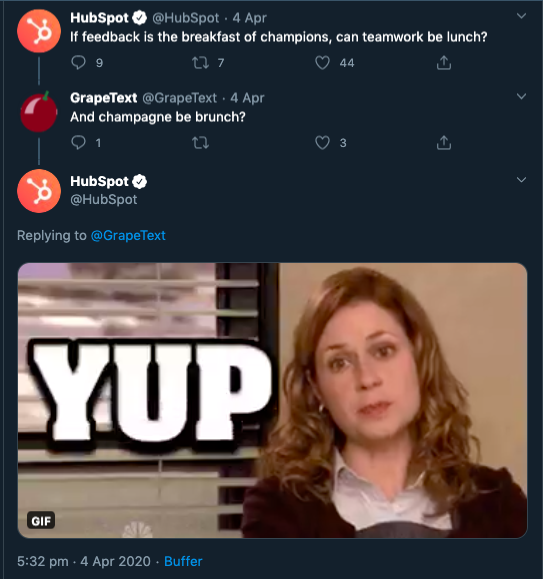Social media is an incredibly powerful tool for brands, with 73 percent of marketers saying that it has been effective for their business. But with great power comes great responsibility, which is why it’s important to know how to use social media the right way.
Given that nearly 3 billion people use social media, I’m betting that the majority of your target audience uses at least one social media platform. And it should go without saying that wherever they are online is where you need to be.
But nowadays, it’s not enough to just have a presence on social media. Scrolling through Facebook, Twitter, Instagram, or LinkedIn, you’ll notice that companies and brands now have well-curated feeds that reflect their brand values and their mission.
There’s a lot of competition for attention on social media. Generally speaking, you only have a couple of seconds to catch someone’s attention, and between dwindling attention spans and algorithms that don’t favor businesses, that’s no easy feat.
However, there is one surefire way to stand out from the crowd on social media, and that’s to build a strong and authentic brand. Your potential customers will be able to recognize your brand as they browse through their social media feeds — and, more important, relate to the content you’re sharing with them.
Having a strong and authentic brand on social media lays the foundation for long-standing and successful customer relationships. In fact, studies show that 54 percent of consumers use social media to research products, and 71 percent who have had a positive experience with a brand on social media are more likely to recommend it to a friend.
A lot of work goes into building a brand, and it doesn’t happen overnight — but there are a few steps that you can take to get started.
Tips for creating a social media brand strategy
- Identify your social media buyer personas
- Establish your voice and style
- Be consistent
- Be human
- Create tailored content and post it at the right times
Identify your social media buyer personas
Establish your voice and style
Be consistent
- Your company name.
- What it is that you do. This is essentially an elevator pitch for your product to help visitors understand what your product or service offering is.
- Keywords associated with your industry. People are more likely to engage with things that they can easily understand. For this reason, adding keywords that are related to your industry to your social media bios can help people understand at a glance what you do. For example, if you’re a URL shortener, “Rebrandly — URL Shortener” could be your title.
- A link. This is probably the most important thing you can include in any of your bios, because it’s going to be the next place people visit after they discover your brand. You might want to direct people to a particular piece of content, your homepage, an online store, or anywhere else your brand lives online.
Be human
Create tailored content and post it at the right times
Not all social media platforms are alike. They focus on different forms of content, attract different audiences, and communicate in ways that are unique to each platform.
Instagram and TikTok, for example, are both visually focused platforms. But even within the context of visual content, TikTok focuses solely on video content, whereas Instagram allows for both videos and images.
Because of these differences, you’re going to need to develop buyer personas for each social media platform you plan on targeting.
You may already be familiar with a buyer persona, but if not, HubSpot defines it as “a semi-fictional representation of your ideal customer based on market research and real data about your existing customers.”
Creating buyer personas for each social media platform will help to determine how to communicate with your audience on each channel, and pinpoint the types of content they’re likely to interact with. If you need help creating buyer personas, there are plenty of marketing resources and examples of buyer personas available to help you out.
The secret to success for any brand is using a unified voice when talking to customers. In a nutshell, a voice is the personality of a brand — it communicates the brand’s mission statement and values as well as showcasing the brand’s characteristics and culture.
While it’s great to have a well-defined overarching brand voice, you’re also going to need to know how to adapt that voice for social media. A brand’s voice might need to be tweaked for the particular channel or platform, the audience in question, or the situation.
All of these external factors determine what’s known as the tone of voice, an extension of a brand’s voice that’s specifically tailored to the needs of one person, a group of people, or in this case, a specific marketing channel.
You can get as detailed as you like when outlining your social media brand voice. As you can see in this graphic created by Stephanie Schwab for the Social Media Examiner, a brand voice can be broken down into four elements: persona, tone, language, and purpose.

It’s easy to imagine how not having a brand voice could negatively impact communication on social media.
One of the main benefits of a well-defined social media brand voice is that any member of your team can pick up a conversation on LinkedIn, respond to a comment on Facebook, or answer a support query on Twitter in the same style and tone as the person who created the voice in the first place. To make this easier, document your brand voice guidelines to ensure they’re always accessible to members of your team.
Research shows that 60 percent of U.S. millennials expect consistent experiences when interacting with brands, which means your brand’s voice, visuals, and overall look need to be consistent across all of your social media profiles.
This can be as simple as using the same logo across all channels — something that may seem simple but is often overlooked. Understandably, using different variations of your logo on different social media platforms could be confusing for visitors, which could result in them having a negative experience.
Take the URL shortener, Rebrandly, for example. Here, you can see their Instagram profile.

Here’s their Facebook page.

And finally, here’s their Twitter account.

Their visual identity remains consistent across all three channels. But being consistent doesn’t start and end with visuals — your voice, language, and tone also come into play.
When we talk about language, we’re generally referring to the language we use to communicate with customers. This can cover informal vs formal language, complicated or simple language, and much more. But another type of language that needs to be considered is the way you talk about your company and product — even your values and mission — on social media.
For obvious reasons, the way you describe your product, describe its features, and generally talk about your company needs to be consistent on social media (and everywhere else, for that matter).
It might seem basic, but putting the time and effort into making sure your bios and about sections are consistent on your social platforms is a big plus in the eyes of your potential customers. The information you include in these sections is your first (and maybe last) opportunity to tell your audience and potential customers exactly what it is that you do, why you do it, and how it’s relevant to them. This is a prime piece of social media real estate and a great way to introduce people to your brand.
You can find tips and tricks to help you optimize these bios, but it’s important to include the following, at the very least:
Without a doubt, this is the most important part of building a brand on social media. Given the nature of the platform, the idea is to be, well, social — the clue is in the name.
The most successful brands know that their customers want to engage in conversations on social media. They’re not expecting to receive a templated, corporate response to their questions. They also know that social media is about promoting a two-way conversation, as opposed to a simple question-and-answer interaction.
HubSpot is a great example of a brand that knows how to be human on social media. Take a look at how they respond to their customers.

In case it isn’t already obvious, the content you post on social media should be tailored to your target audience on each platform. For example, a lot of brands make use of Instagram’s visual-oriented platform to post graphics containing inspirational quotes, statistics, and other conversation-provoking pieces of content. Twitter’s limited character count means that the focus there is on short and concise messaging, and LinkedIn attracts a professional audience, so the content you post there could be more industry-centric.
In addition to posting the right content, you also need to know the best time to post. Unfortunately, there’s no one answer to this question as it largely depends on the type of business or industry you’re in.
Buffer, HubSpot, and Sprout Social have conducted research on engagement rates relative to time posted on each social media channel, which gives us a general idea of good and bad times to post. You can see that on Facebook, Wednesday is apparently the best day to post, whereas content posted on a Sunday isn’t likely to get much traction.

Wrapping up
Building a brand takes time and dedication, but having a strong foundation makes it a lot easier.
Above all, having a brand presence on social media is about giving your customers a positive experience. It’s an extension of the experience you want them to have with your brand on your website or your blog, which means you should put the same amount of care into developing your social media brand as you do your overall brand identity.
“By ensuring that your brand is consistent, authentic, and human on social media, you’re bound to attract a lot of happy customers, both future and present.






















































































Send Comment: